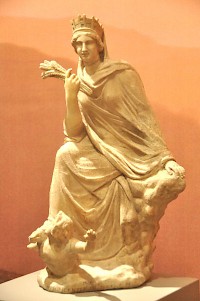Tyche of Antioch
The Tyche of Antioch: statue of the goddess of fortune, created by Eutychides of Sicyon. It is the best-known piece of Seleucid art.

In the Greek world view, Tyche (Τύχη) could be the personification of the fortune of a city, a nation, or a person. According to Hesiod, she was a daughter of Oceanus and Thetys;note Pindar argues that Zeus was her father.note The Romans would call her Fortuna.
She became an important, frequently venerated, goddess in the decades after the conquests of the Macedonian king Alexander the Great (r.336-323), when the outcomes of many wars seemed to depend on nothing but capricious luck. Hellenistic mythographers now presented her as the daughter of Hermes and Aphrodite; other poets connected her to the cult of Nemesis or the Agathos Daimon ("good spirit").note Sometimes, she was compared to Cybele or Isis.
Alexander had founded many new cities and his successors continued this policy. The good fortune of the ruler who was able to create or destroy a city, was one of the best examples of the influence of Fate, and it comes as no surprise that one of those new cities, Antioch, venerated its own fortune in a temple, the Tychaion.
The cult statue was made by Eutychides of Sicyon (c.335-c.275), a pupil of the great Lysippus. It is a remarkable statue, because you can look at it from different directions, unlike many older statues.

This bronze statue is essentially an assemblage of symbols, almost an allegory. The goddess is seated on a rock (=Mount Sipylus), has one foot on a swimming figure (=the river Orontes), and has several ears of grain in her hand (=the city's fertility). On her head rests a mural crown, to make us understand that this statue, which might as well have been the symbol of a nation or a province, represented a city. This motif was an orientalizing influence: mural crowns had been used in the art of ancient Elam and Assyria. Because the statue was often copied, this artistic motif spread all over the Mediterranean.
The original statue is lost and archaeologists do not even have a clue where they might find the Tychaion. However, there are many copies of the statues, like the exceptionally perfect one at the Vatican, shown above.
 The Tyche of Antioch, grain |
 The Tyche of Antioch |
 The Tyche of Antioch |
 The Tyche of Antioch, river Orontes |
 Cyprus, Oil lamp with the Tyche of Antioch |
 The Tyche of Antioch (figurine) |